With its Project Spark creation game, Microsoft has a big opportunity to capture the imagination of gamers and bottle it. If it succeeds, Spark could build for Microsoft a user-generated community akin to the phenomenally popular block-building title Minecraft — if it strikes the right balance.
Players will be able to use Project Spark to design their own game characters, worlds, and virtual objects. It has to be easy to use so that anybody can create, but it also has to be deep and flexible enough so it doesn’t limit creativity. Microsoft will soon find out what happens when it turns over the keys to the car to its gamers. The open beta test is live today.
There’s a lot at stake in coming up with this magic formula for accessibility and creativity. If it works, Microsoft’s own gamers will build a sharing community, which they can sustain by creating much more content than Project Spark’s own developers, dubbed Team Dakota, can themselves.
Spark is ambitious because it is designed to run on anything from a PC to a huge touch-screen television. You can use an Xbox One with Kinect to insert your own image into a virtual landscape or sweep your hand over a Surface 2 tablet to populate it with trees. The title will be free-to-play so that anyone would be able to pick it up and play with a minimum of friction. The creative action is more like sculpting, not coding.
The title is still in closed-beta testing, and players are creating all sorts of cool game worlds, such as Star Wars or Harry Potter fan games. Many world-building publishers want to duplicate the success of Mojang’s Minecraft, which has more than 100 million registered users. But that has been particularly difficult.
I visited Team Dakota’s headquarters in Redmond, Wash., where leaders like creative director Henry Sterchi and lead game designer Brad Rebh have grappled with this challenge for three years.
Creating Project Spark
I think it has a shot. The creators have put a lot of thought into the whole system.
“Historically, we’re inherently born with the need to create and play. They’re natural tendencies in us,” Sterchi said in an interview with GamesBeat. “When you think about grounding it from there — you look at that concept and say, ‘Everyone wants to play and wants to create.’ We had an opportunity to do some blue-sky investigations, and we pivoted straight toward that. What does it mean to play? What we saw was, if you think about a kid playing, they run around their neighborhood. They tell stories. They go on adventures.”
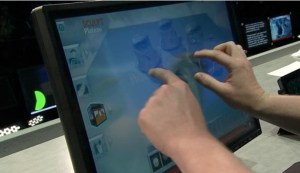 He said, “You look at the modern day and … now they’re sitting in front of a television. They’re having media given to them. When they play games, they go from left to right. They don’t have that opportunity to make their own adventures. So we started exploring that. We looked at everything from Lincoln Logs to play behavior in general. We started thinking past video games. That’s when we started thinking about the genesis of this idea.”
He said, “You look at the modern day and … now they’re sitting in front of a television. They’re having media given to them. When they play games, they go from left to right. They don’t have that opportunity to make their own adventures. So we started exploring that. We looked at everything from Lincoln Logs to play behavior in general. We started thinking past video games. That’s when we started thinking about the genesis of this idea.”
The first major “exploration” has a fantasy theme. So most of the generic objects being created in Project Spark are items that would fit into a fantasy world, like orcs or wizards and medieval buildings.
Everybody at Team Dakota is housed on a floor of an office building in Redmond, Wash., away from Microsoft’s main campus and on the edge of a forest. They started with Kodu, a visual programming language used in schools around the world. It is used by everybody from adults to children ages 8 and up. They combined that with something that enabled people the freedom to “create their own worlds and tell their own stories,” Sterchi said.
You don’t need any programming experience to create in Spark because Microsoft has hammered away at Kodu so that it is a tool that anybody can use. It has been modified and gamified so that players are rewarded for learning programming skills without really realizing that they’re learning programming skills.
Spark has things like lesson plans that, if you fulfill them, you get rewards. Brad Rebh said the language is constrained so that you can’t write an incorrect line of code.
“The key to our vision was the YouTube mentality of giving everybody that camera,” Sterchi said. “You can create something on desktop and go straight to your Xbox One without any additional work from the creator. We had to make the act of creating fun. So our motto is creating is playing.”
Creating things
You can seamlessly go back and forth from input mechanisms like the mouse and keyboard, touch, and a game controller. If you make a controller-based game, it automatically maps to other platforms so it works with touch or a mouse and keyboard. That means there are “multiple access points,” which make the experience more accessible for both players and creators.
A tutorial teaches you how to create something. You can browse other creations, or make your own. A blank world stares back at you. On a touch-screen TV, which is the best design interface, you can “paint” a landscape’s features such as trees or rivers by using your fingers to trace a path across the screen. The ground that you build on is flat and works well for gameplay, so characters can walk across it. If you aren’t happy with it, you can scrub it out.
“You can really hone down and change a single pixel if you want to,” Sterchi said.
You can click on an icon to access “props” that you can insert into the world, like boxes. You can create new props by gluing objects together or tearing the props apart. The assets in the library are like building blocks, such as doors and windows. You can see these objects from multiple perspectives. Some of the creations have default behaviors once you put them in the world. A character can jump or walk. A goblin will attack your character if you place it in the world. Birds will fly away if you approach them.
Objects also have physical characteristics. You can change the weight and mass of an object so you can make your own physics-based game with boulders rolling down hills at your enemies. You can even put a “goblin brain” into a bird, and that bird will attack your character as an enemy.
Members of the team do a “game jam” every other week, using the tools to build their own games. They test the tools and show off their works to others. Concept artists brainstorm a lot of possibilities, and the animators and artists make them into objects that can be used as templates in Project Spark. That saves players time, but it’s not meant to constrain them.
The team is a mix of veterans. Sterchi, who started his career at Nintendo, has been in the industry for 20 years. Members of the Halo team have moved to Team Dakota, and there are a bunch of new hires. There are operations managers, community managers, and people who make sure that everything is compliant with child protection laws. Spark will be on Windows 8.1 PC, Xbox One, and the Xbox 360.
Saxs Persson, the executive producer on Project Spark, said that the question of the moment is, will people create games or shadows of games?
What users have already created
So far, the beta testers have run with it. More than 70 percent of the usage is in creating.
“We’re seeing what we were hoping for — not that 5 percent you might expect to see creating user-generated content. Seventy percent of the time spent in the game is creative,” Sterchi said. “It’s resonating with people.”
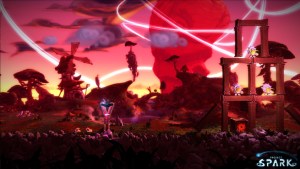 The volume of the material created so far suggests that Microsoft is on to something and that users are spending hours on the creations. While the world has a medieval theme, players are taking the objects and creating things like machine guns.
The volume of the material created so far suggests that Microsoft is on to something and that users are spending hours on the creations. While the world has a medieval theme, players are taking the objects and creating things like machine guns.
One 29-year-old player has re-created the whole first level of the original Xbox game Fable. He never programmed before, but he was able to faithfully product just about everything you can see in Fable.
“A lot of the special nature of this comes from how fast you can construct entire worlds, how powerful it can be if that’s how deep you want to go,” Sterchi said. “It’s the ability to create life and behavior. We’ve seen people creating things that react to their own conditions and to their own game constructs. It’s different, in my mind, from what you would historically see, where there’s maybe some sliders you can change to affect a situation, or there’s a character customization option from the game.”
He said, “You can go in here and create behavior that we never made. We didn’t inherently build this thing into the game, but somebody went and made that. I can’t think of anything else that replicates that right now.”
Some online worlds, like developer Linden Lab’s Second Life, are a great outlet for people who are already artists. They can create elaborate showpieces. But can most people duplicate that kind of artistry? Microsoft, by contrast, is tapping tools like its Kinect 3D sensing camera to allow people to capture images and project them inside the game world.
“We have a lot of work around Kinect,” Sterchi said. “Kinect is opening the doors to a lot of special things. We’re doing full-body motion capture, voice capture, and facial expression capture. We have several features around just making sure we can scale. We can take in the masses and have that amount of concurrency. Right now, you can project them on the characters we have. You can put them on a troll or a goblin, taking all of your body motions. We have some more plans as far as how we can use Kinect in the future that we haven’t revealed, around some more of those elements.”
Claude Jerome, a Project Spark designer, showed us how he could use Kinect to capture his “Thriller dance” based on Michael Jackson’s “Thriller” music video. He inserted the move into Spark as an animation, and he could then get the characters in Spark to do the dance.
Microsoft’s challenges in matching Minecraft
There are, of course, paths that would ruin the chance for Project Spark to become the next Minecraft.
Microsoft faces some tough questions that will shape how far it can go with Project Spark. Sterchi said that if users create works that infringe upon the copyrights of others, Microsoft will take those creations down. It will, however, consider whether the works are illegal copycats or are defensible homages that are creative in their own right. Most brands are OK with homages as it puts more eyeballs on the brand.
Microsoft will further reduce the risks of take-down lawsuits by prohibiting users from profiting from their creations within the game. They can’t, as they can in Second Life, create something and then sell it to other users.
But will Microsoft allow players to take their creations, such as a game avatar or character, and export that model to another game? Will it let players create something that they can take out of Spark’s world? Can they take them to a 3D printer and re-create the image in the real world? These questions are bound to come up and will determine what kind of overseer Microsoft will be.
In the meantime, Project Spark is leading to all sorts of cool creations, with homages to Sonic the Hedgehog, Fable, Sauron from the The Lord of the Rings, and many others. In one of the worlds I saw, a player took the models for some ordinary knives and then made them part of a gigantic sculpture. Some creations are quite crude, but they may create the spark for someone else to run with. Every person has the right to take someone else’s shared creation and build upon it and remix it into something new. Eventually, if players do that often enough, they can use their collective creativity to create game worlds of enormous beauty. But Microsoft never loses track of what each individual contributed.
“People ask me a lot about what I’m most excited for. I’m most excited about people creating the unexpected,” Sterchi said. “The barrier to making a new mechanic, making something that’s never been seen before and never been played before, has never been lower. Project Spark facilitates that like nothing else. That’s we’re seeing in the community. We’re seeing game mechanics we’d never thought of. That’s what we’re excited about.”
Microsoft hasn’t revealed how it will make money. By making it free-to-play, it will make Project Spark more widely adopted. But it won’t last if the company doesn’t make money from it. Minecraft fans have shown that people will gladly pay for something great. Microsoft will sell things like add-on packs that let you put on fireworks shows or build a castle.
Later this year, we’ll see if Microsoft has learned the right lessons. Project Spark is shipping in 2014.
VentureBeat's mission is to be a digital town square for technical decision-makers to gain knowledge about transformative enterprise technology and transact. Learn More
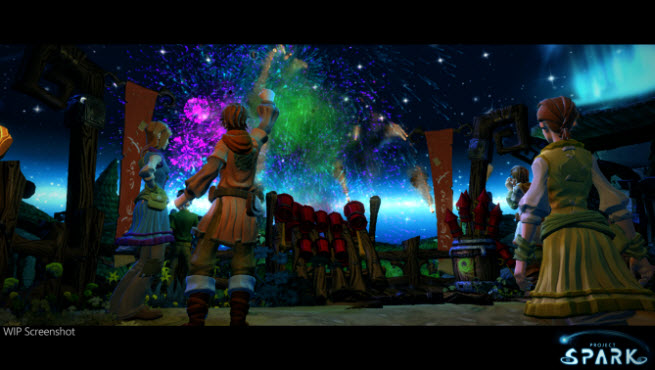

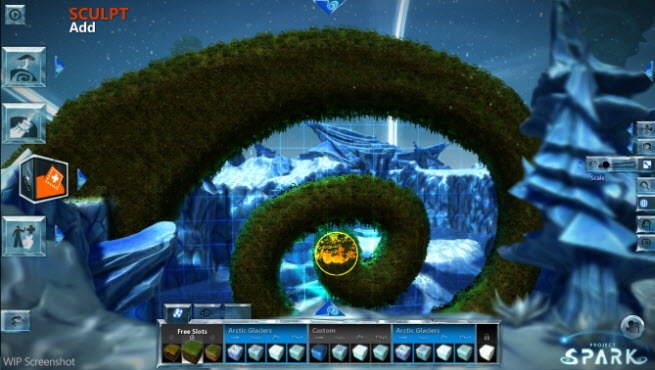



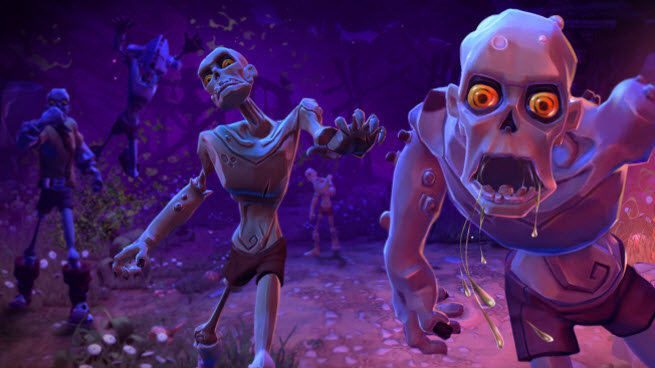




![Reblog this post [with Zemanta]](http://img.zemanta.com/reblog_e.png?x-id=3c3f57ca-c595-44da-9051-51283a1be7ae)
